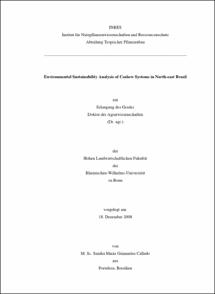Environmental Sustainability Analysis of Cashew Systems in North-east Brazil

Environmental Sustainability Analysis of Cashew Systems in North-east Brazil

| dc.contributor.advisor | Janssens, Marc J. J. | |
| dc.contributor.author | Guimarães Callado, Sandra Maria | |
| dc.date.accessioned | 2020-04-13T16:05:19Z | |
| dc.date.available | 2020-04-13T16:05:19Z | |
| dc.date.issued | 18.02.2009 | |
| dc.identifier.uri | https://hdl.handle.net/20.500.11811/3939 | |
| dc.description.abstract | This study aims to provide a comprehensive insight into the status and development prospects of the cashew farming systems in North-east Brazil, where thousands of small growers depend on cashew production. The smallholder units are important economic-social groups within rural areas in the north-eastern region. After the introduction of dwarf-precocious cashew, the resulting higher cashew yields in the north-eastern region brought about great expectations concerning the rural and regional development prospects due to the increasing income of growers. This study is an inquiry into the cashew sector, focusing on the states of Ceará and Piauí, main producers of cashew in Brazil. The main goal of this research is to evaluate the cashew farming systems, identifying the main aspects that affect the yields of the cashew farming systems. Specifically, this research main focuses were on: (i) general characteristics and classification of the cashew growers and their farming systems, specially the factors that affect the cashew nut productivity in both states; (ii) litter fall production and biomass partitioning of the common and dwarf-precocious types of cashew tree and; (iii) an accounting of inputs and outputs of environmental and economic contributions to the cashew farming systems. To collect all this data, 254 farmers were interviewed and an experiment of litter fall was conducted during 24 months at EMBRAPA-Pacajus, Ceará. The main results of this study were: (i) cashew farmers in the states of Ceará and Piauí had different characteristics and a cluster analysis helped to identify seven homogenous groups from the large number of cashew farming systems observed in this study; (ii) cashew nut production in North-east Brazil was variable across climatic, geographic and agronomic conditions; (iii) the common cashew tree had higher litter fall production. Additionally, the common type also showed better dynamic stability of litter fall production; (iv) the dwarf-precocious cashew tree demonstrated greater biomass production and accumulated more energy in terms of biomass partitioning. Beside this, higher cashew production was observed in the dwarf-precocious type; (v) the energetic assessment of inputs and outputs of farming systems is a viable tool to qualify and quantify the environmental and economic functioning of agricultural ecosystems. The environmental comparison becomes even more convincing when solar transformity is used as a common yardstick and; (vi) the homestead cashew farming system outyielded all other systems in terms of environmental performance and sustainability. The higher cashew yield of the Irrigated model could only be achieved at the expense of higher ELR (Emergy Load Ratio) and EER (Emergy Exchange Ratio). | en |
| dc.description.abstract | Umweltverträglichkeits-Analyse der Cashew-Anbausysteme im Nordosten Brasiliens Diese Studie zielt darauf ab, einen vollständigen Überblick über den Status und die Entwicklungsaussichten der Anbausysteme für Cashewbäume im Nordosten Brasiliens zu geben. Tausende von kleinen Landwirten sind vom Cashewanbau abhängig. Diese kleinen Bauern sind wichtige ökonomische Sozialgruppen innerhalb der ländlichen Gebiete im Nordosten. Nach der Einführung von schwachwachsenden Cashewbäumen eröffnen die zu erwartenden Ertragssteigerungen und die daraus resultierenden höheren Einkommen gesteigerte Erwartungen im Hinblick auf die landwirtschaftlichen und regionalen Entwicklungsmöglichkeiten. Diese Studie analysiert das Cashew Anbausystem, besonders in den Staaten von Ceará und Piauí, den Hauptproduzenten der Cashewnuss in Brasilien. Die Hauptziele dieser Studie waren: (i) die Klassifizierung des Anbausystems für Cashewbäumen, insbesondere der Faktoren, die die Produktivität des Cashewbaumes beeinflussen; (ii) Vergleich von Blattfall und Biomasseproduktion zwischen den herkömmlichen und schwachwachsenden Cashewbäumen und; (iii) Bilanzierung von ökologischen und ökonomischen Einflussfaktorendes Cashewanbaumsystemes. In dieser Studie wurden 254 Landwirte befragt und ein Blattfallversuch in EMBRAPA-Pacajus, Ceará über 24 Monate durchgeführt. Die wichtigsten Ergebnisse dieser Studie waren: (i) Es gab Unterschiede zwischen den Standorten, sowohl bei der Betriebsleitung und Betriebsstruktur als auch im Anbausystem. Mit Hilfe einer Blockanalyse konnten sieben homogene Gruppen gebildet werden; (ii) die Cashewnuss-Produktion im Nordosten Brasiliens schwankt entsprechend den klimatischen, geographischen und landwirtschaftlichen Bedingungen; (iii) der herkömmliche Cashewbaum weist höhere und stabilere Werte des Blattfalls auf; (iv) der schwachwachsende Cashewbaum produziert mehr Biomasse und zusätzlich konnte eine höhere Produktion von Cashewnüssen beobachtet werden; (v) die Energiebilanz der Anbausysteme ist eine geeignete Maßnahme zur Qualifizierung und Quantifizierung der ökologischen und ökonomischen Auswirkungen der landwirtschaftlichen Systeme. Dieser Vergleich wird sogar noch deutlicher wenn die "Transformity" als ein allgemeiner Maßstab verwendet wird und; (vi) das Modell "Familienbetrieb" hat die besten Ergebnisse im Bereich Umwelt und Nachhaltigkeit. Die höhere Cashewnuss-Produktion des Modells "Bewässerung" konnte nur auf Kosten von höherem ELR (Emergy Lasts-Verhaltnis) und EER (Emergy Austausch-Verhältnis) erreicht werden. | en |
| dc.language.iso | eng | |
| dc.rights | In Copyright | |
| dc.rights.uri | http://rightsstatements.org/vocab/InC/1.0/ | |
| dc.subject.ddc | 630 Landwirtschaft, Veterinärmedizin | |
| dc.title | Environmental Sustainability Analysis of Cashew Systems in North-east Brazil | |
| dc.type | Dissertation oder Habilitation | |
| dc.publisher.name | Universitäts- und Landesbibliothek Bonn | |
| dc.publisher.location | Bonn | |
| dc.rights.accessRights | openAccess | |
| dc.identifier.urn | https://nbn-resolving.org/urn:nbn:de:hbz:5N-16762 | |
| ulbbn.pubtype | Erstveröffentlichung | |
| ulbbnediss.affiliation.name | Rheinische Friedrich-Wilhelms-Universität Bonn | |
| ulbbnediss.affiliation.location | Bonn | |
| ulbbnediss.thesis.level | Dissertation | |
| ulbbnediss.dissID | 1676 | |
| ulbbnediss.date.accepted | 13.02.2009 | |
| ulbbnediss.fakultaet | Landwirtschaftliche Fakultät | |
| dc.contributor.coReferee | Pohlan, Jürgen |
Dateien zu dieser Ressource
Das Dokument erscheint in:
-
E-Dissertationen (1120)




